Epidote (silicates) Epidote (pistatsit)
 Diagnostic Card.
Diagnostic Card.
On the picture. Well-formed crystals of epidote.
Ca 2 Al 3 O OH SiO 4 Si 2 O 7
Crystal system monoclinic
Hardness 6-7
Specific gravity 3.35-3.38
Cleavage is perfect
Fracture conchoidal, wrong
Green colour
Color gray powder
Gloss glass
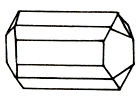
Epidote or pistatsit - complex calcium silicate, aluminum and iron. The name is derived from the Greek epidosos - increment. In section one side of the prism dlineee other. Synonym associated with pistachio color. Epidote confused easily with idocrase.
Bright glass shine. Translucent, sometimes transparent. Colours: pistachio-green (hence the second name), dark green. Dash gray. Fracture conchoidal, uneven, splintery. Cleavage is perfect. Formed in skarns and metamorphism of crystals - in drusy cavities and cracks. The crystals (monoclinic system), elongated, prismatic, needle, rich in faces, often grouped in bunches, dense radiating aggregates. Frequent counterparts. Distribution Area: Erzgebirge (Germany, Czech Republic), the Alps, the Urals and in the CIS Alaska.
Clinozoisite - malozhelezistaya variety of epidote gray or light pink color. Piedmont - a manganese epidote kind of dark red color. It forms fibrous aggregates.
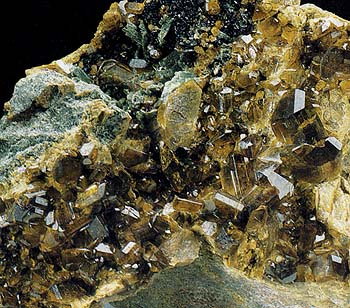 Mentioned epidote also called pistatsit. Presented as a prismatic crystals and struchkoobraznymi and fibrous aggregates. Characterized counterparts. Mineral painted in dark green, pistachio-green, greenish-yellow color; glass luster, cleavage along the perfect base.
Mentioned epidote also called pistatsit. Presented as a prismatic crystals and struchkoobraznymi and fibrous aggregates. Characterized counterparts. Mineral painted in dark green, pistachio-green, greenish-yellow color; glass luster, cleavage along the perfect base.
Diagnostic features.
Insoluble in acids, is melted by a flame lighter than clinozoisite.
Origin.
The origin of this mineral is mainly metamorphic rocks. It is formed at the contact of limestone with shale, as well as in the cracks among femic rocks (amphibolites, gabbro, and so on. N.). Furthermore, it may be formed in the process of alteration of calcium plagioclase.
Place of Birth.
Excellent examples of epidote in Italy are known in Val d'Allos, Val de Susa and Traverselly (province of Turin), and also from Val Malenko (province of Sondrio). Currently, the best specimens come from France, Switzerland, Norway, Brazil and various countries of North America. Almost all of the samples, the most interesting from the point of view of the jewelry come from Knappenvalda (Austria).
Application.
It is used in jewelry. In the Urals, found the bottle-green transparent variety of epidote - Pushkin, which is subjected to cutting.
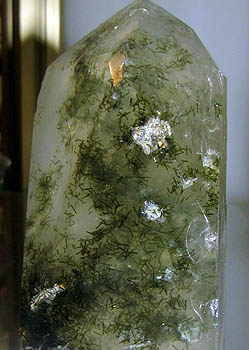
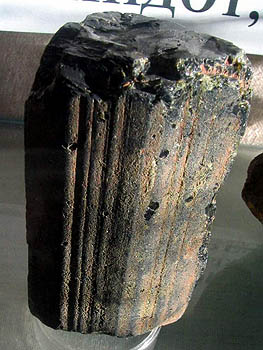
Left. Quartz with inclusions of epidote. Gorbunovo near Lower. Tagil, Sr.Ural, Russia.
On right. Epidote. Vuhemar, Madagascar. Prismatic pseudotrigonal crystal. Photo: © AA Evseev.
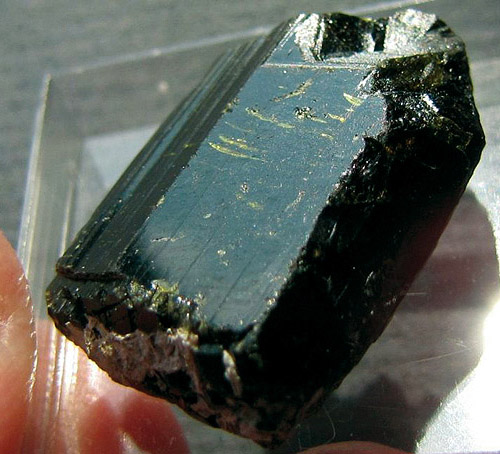
Epidote. Bel-Alma, Eastern. Pamir, Tajikistan, CIS. Photo: © AA Evseev.
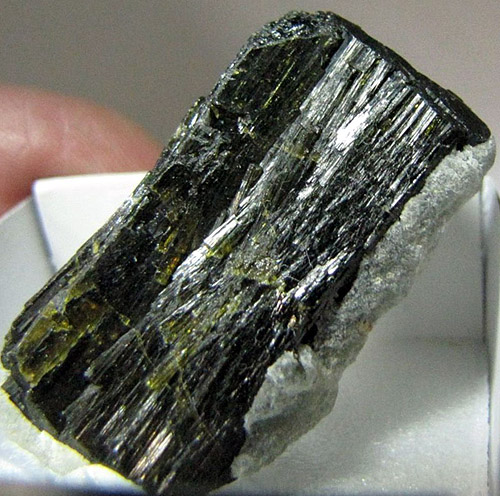
Epidote (split crystal), debate. Benduku, Kayes district, Mali. Photo: © AA Evseev.

Epidote. Pampa Blanca, Castrovirreyna, Huancavelica Dep., Peru. Photo: © AA Evseev.
Zoisite - rocks containing large amounts of epidote, is inexpensive gems that are rarely used in jewelry applications. Zoisite (epidote) ornamental quality visual and hardness resemble jasper or serpentine species with which this mineral often be confused. For the price of products ornamental epidote and zoisite associate with this group, and even stones can cost a bit more expensive because of the relative rarity. Zoisite and its variants have a distinctive glass shine. The mineral has a bright interesting color for any artificial and natural light and looks much brighter than traditional jasper. aniolity that are spectacular decorative material - In 1954, the beautiful green tsoizitovye rocks with inclusions of hornblende and red corundum were discovered in Tanzania. There are marked transparent green, light brown and colorless crystals.


Left. Epidote. Gold Stone, at district Severouralsk. North. Ural, Russia.
On right. Epidote in quartz. North. Ural, Russia. Photo: © AA Evseev.

Epidote on quartzite, p. Brutichie, Azov Sea, south-east of Ukraine, CIS.

"Hallmark" Dashkesen are split epidote crystals. Author photo album
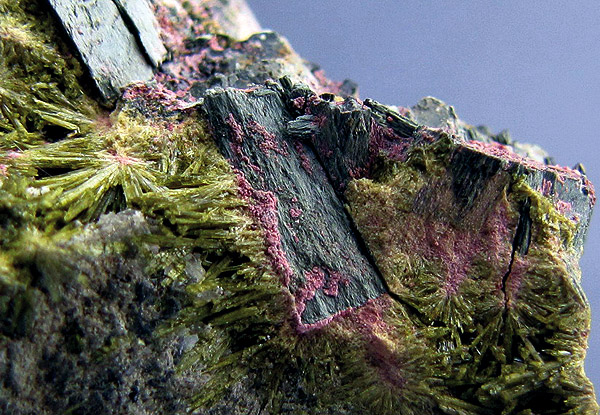
Epidote (green), erythrite (raspberry), tremolite. Dashkesan, Azerbaijan, CIS. Photo: © AA Evseev.
Jewels began to consider zoisite since 1967, when Tanzania beautiful transparent crystals of sapphire-blue was found, purple, green and blue. This variety was named zoisite tanzanite. When artificial light amethyst stones become purple color. Blue coloring new variant associated with the presence of vanadium, and greenish blue - with the presence of vanadium and chromium. When heated to a temperature of 400-500 o C blue color deepens. Tanzanite is characteristic of a very strong pleochroism: from blue to purple to green (or brown). Tanzanite crystals are found in veins in gneisses. Weight of the largest of them reached 122.7 and 220 carats. Processed resembles tanzanite sapphire, from which it differs in physical properties (hardness 6 - does not scratch glass, unlike sapphire).








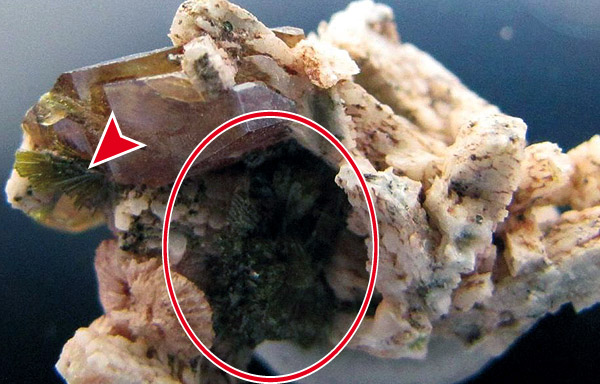
Titanite, epidote (grass green), feldspar. Imilchil, Morocco. Photo: © AA Evseev.
- Gatchell - "New Almadén snag" - arsenide and antimony sulfide (modern sulphosalts)
- Antimony - toxic metal (semi-metal) are widely used in industry, medicine and engineering
- Zirconium - a rare and non- metal and dangerous jewel in the oxide and salts
- Gold - yellow dangerous and toxic metal -date and accurate digital cable technology
- Sulphur - a golden-yellow toxic substance and a sign of volcanic activity
- Cadmium - a toxic uncirculated unknown wide range of people silvery metal
- Lead - a poisonous gray simulator silver metal and toxic metal snag
- Arsenic - poison classic medieval and modern poisoners and medicine in medicine
Toxic and hazardous radioactive rocks and minerals
** - Poisonous stones and minerals (obligatory check in chemical laboratory + clear indication of toxicity)
** - Radioactive rocks and minerals (obligatory check on a regular dosimeter + ban on the open sale of radioactivity in the event of more than 24 mR / hour + additional measures to protect the population)
Catalog minerals and gems in groups of the world
** - Poisonous stones and minerals
** - Radioactive rocks and minerals



Comments
Commenting, keep in mind that the content and the tone of your messages can hurt the feelings of real people, show respect and tolerance to his interlocutors, even if you do not share their opinion, your behavior in terms of freedom of speech and anonymity offered by the Internet, is changing not only virtual, but real world. All comments are hidden from the index, spam control.